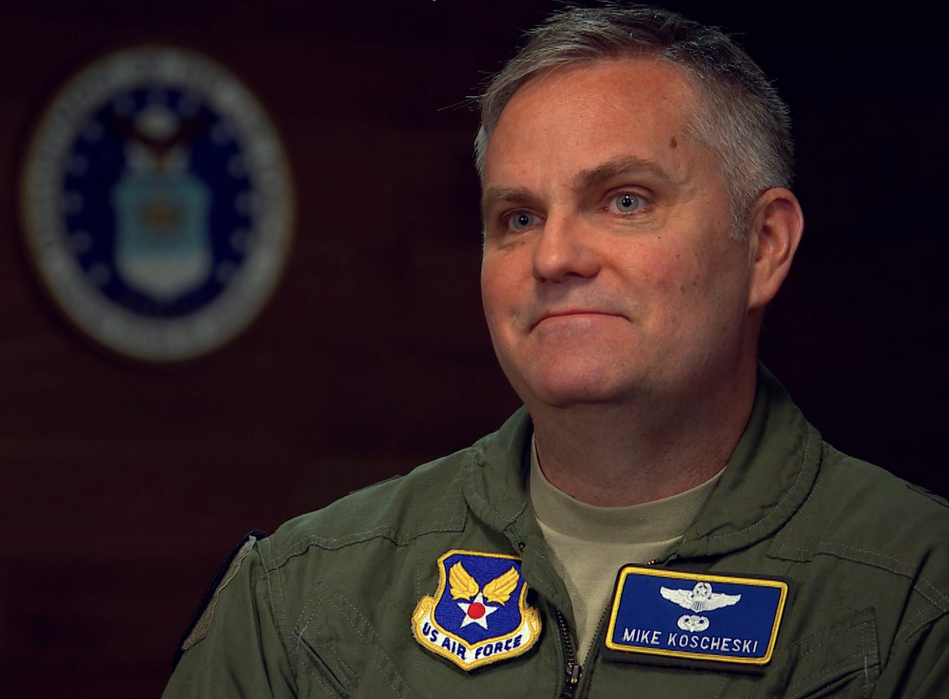
Brig. Gen. Mike Koscheski, the outgoing head of the Aircrew Crisis Task Force, says the service is starting to move the needle on the pilot shortage gap. Air Force photo by TSgt. Samantha Ducker.
The Air Force now has a five-year plan for closing the pilot shortage gap, but the outgoing head of the Aircrew Crisis Task Force said the service already is seeing some positive momentum.
Brig. Gen. Mike Koscheski, who was tapped to stand up and lead the Aircrew Crisis Task Force last August, is moving on to US Air Forces in Europe-Air Forces Africa, where he will serve as the new director of plans, programs, and analysis. He will be replaced next week by Brig. Gen. Chris Short—a command pilot with more than 3,300 flight hours in the T-37, T-38, A-10, and F-15E—who currently serves as the senior defense official and defense attaché in London.
“When I first started? there was no timeline, just initiatives,” said Koscheski. Over the last 10 months his team, which expands across the Air Force and includes members from various major commands, has dug deep into the pilot shortage challenge, which USAF leaders have repeatedly called a “national crisis.”
About half of the 69 initiatives aimed at reducing the pilot shortage, which range from long-overdue increases in aviator incentive pay to increasing administrative support in the squadrons, are currently being implemented. The rest are still in the “evolution/development” phase, said Koscheski.
The biggest thing his team has done to date, he said, is integrate those ideas across the service. The five-year recovery plan, which aims to get pilot manning at 95 percent by Fiscal 2023, was the structure used to do that.
The plan is centered on three critical areas: retention, production, and requirements.
Retention, he said, is “critically important,” and one of the areas the service has seen the most progress. Though increases in monetary compensation have gotten the most attention, and are no doubt “big drivers” to closing the gap, the service also has made great strides in its talent management. He cited the Talent Marketplace system—a web-based platform used by the Air Force Personnel Center to create “tailor-made” assignments for officers and provide more lead time before those assignments are announced—as a prime example.
Another driving factor has been the increase of administrative support in operational squadrons, which not only frees up officers to spend more time with their families, it’s also allowed the pilots to focus more on their primary mission.
“We’ve learned that as we increase admin support and optimize the efficiency of pilots in primary duties, sometimes instead of trying to create more aircrew, if we create more support personnel or keep the aircrew we have healthy, we can get more production out of less number of aircrew,” said Koscheski.
The Air Force also has a new program called “optimizing the human weapon system,” which is focused largely on protecting combat air force pilots’ necks and backs.
“We’re getting great reviews from wing commanders in the field. We’re literally taking better care of our pilots and treating them like professional athletes,” he said. “We’re seeing big gains in that area.”
One of the key things the service has done on the production side is to revamp the undergraduate pilot training syllabus. Koscheski said that effort was the perfect example of “never letting a good crisis go to waste.” Although the Air Force trained about 200 fewer student pilots than it had anticipated due to the month-long grounding of the T-6, USAF’s primary trainer, due to hypoxia-like issues, the stand down gave instructor pilots and commanders an opportunity to get together and redesign and “optimize” the UPT syllabus.
“So, first and foremost, the redesign was done to create better pilots. Period,” he said. But, “The side benefit is it now takes five to nine weeks less to get pilots through pilot training, so … we’re able to get more [students] through [the pipeline], but now it just increases production.”
Now that the long-awaited syllabus revision is complete, Koscheski said USAF is turning its attention to other initiatives aimed at increasing production, such as the possible introduction of contract instructor pilots.
“We are looking at those options,” he said, noting the service is focusing first on UPT before turning its attention to more advanced training.
The Air Force remains about 2,000 pilots short across the Total Force, but senior leaders have been hesitant in recent months to break down that figure much more, other than to say the majority of the gap falls in the fighter community. Koscheski said rather than just releasing an aggregate number that lacks context, the task force wants to measure the shortage against those three lines of effort as well as the recovery plan to help put those numbers in perspective.
For example, just because the shortage grows from one year to another, it doesn’t necessarily mean that pilots are leaving the service in droves, he said. More than likely the requirements are just increasing. For example, as the F-35, KC-46, and possibly a new light attack platform come online, it will take time for the inventory—AKA pilots— to catch up to requirements, he noted.
“We think we’ve really flattened the curve. We think we’re not going to drop as much as we have in previous years, so our initiatives are starting to work,” he told Air Force Magazine. “That’s … setting the conditions for recovery. What I think you’ll see going forward is at the end of Fiscal 2018, … we’ll measure ourselves against where we modeled to be in 18 and then see that as we go along year-by-year. It will be a more meaningful and accurate measure of our capability based on inventory [and] … requirements.”
As for the details of the five-year plan, Koscheski said USAF is still working out some of the “progammatics,” but he expects it to be released in the near future.